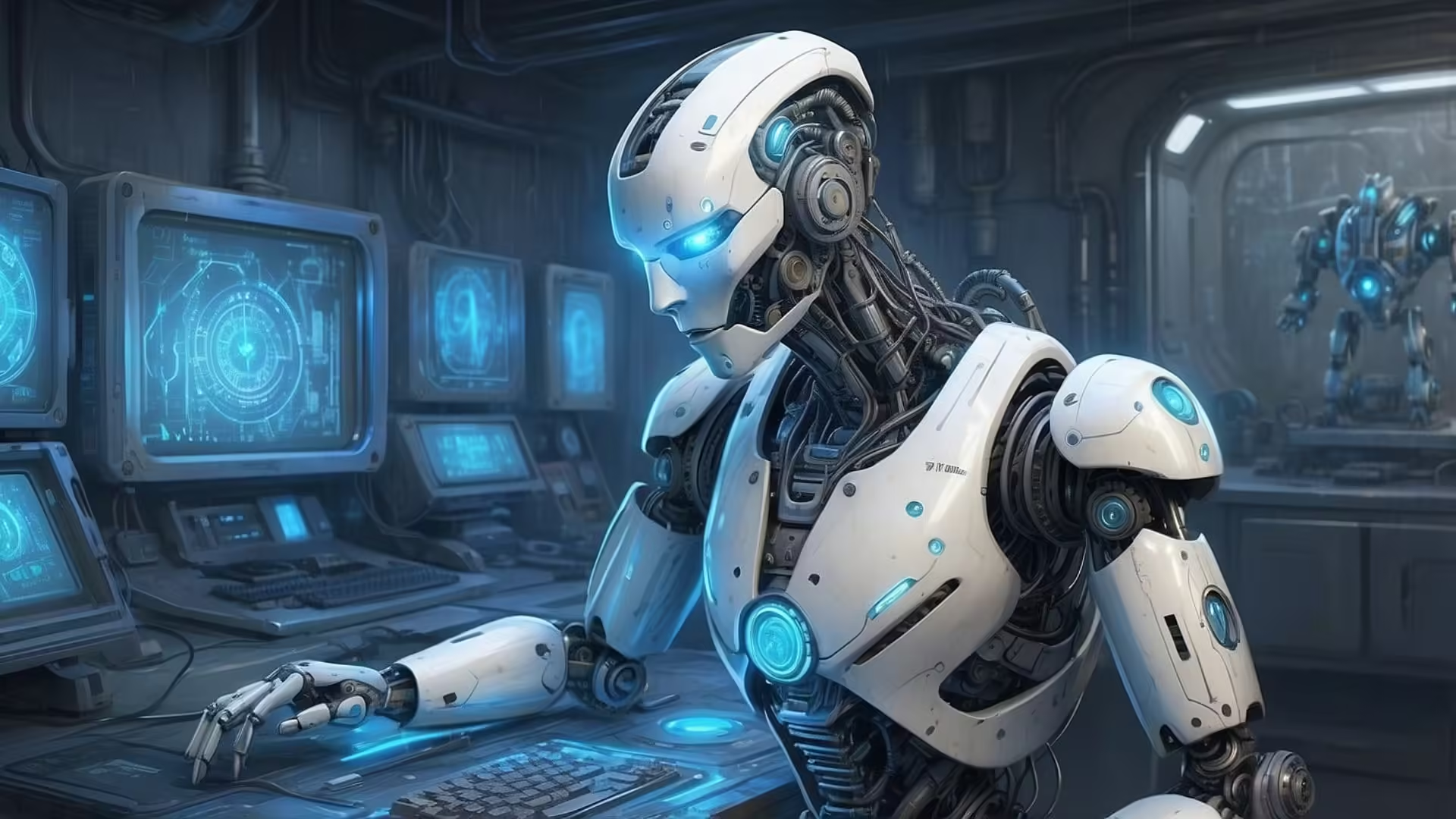Robotics is an interdisciplinary field that combines engineering, computer science, and artificial intelligence (AI) to build machines capable of performing complex tasks. What started as a dream in science fiction has now become a reality, with robots playing significant roles in industries like manufacturing, healthcare, and space exploration. But robotics isn’t just about assembling cool gadgets—it’s about pushing the boundaries of technology to create intelligent machines that can solve problems, assist humans, and even act autonomously in certain situations. In this article, we’ll explore the basics of robotics, its applications, and the future of this exciting field.
What is Robotics?
Robotics is the science and technology of building machines, or robots, that can perform specific tasks, often mimicking human actions. These robots can range from simple machines that follow pre-programmed instructions to advanced systems that use sensors and AI to learn and adapt. At its core, robotics involves the integration of mechanical parts, software algorithms, and sensors to create machines that can operate in real-world environments.
Robots come in many forms—some look like humans, others resemble animals, and many are simply functional devices designed to perform specialized tasks. A robot vacuum cleaner, for example, might not look like a traditional robot, but it uses sensors, motors, and algorithms to navigate your home and clean floors autonomously.
Key Components of Robotics
Several key components work together to make robotics possible. First, there are the mechanical systems, which include motors, joints, and frames that allow the robot to move and interact with its environment. Then there are sensors, which provide feedback by collecting data—such as distance, temperature, or movement—that the robot uses to make decisions. Artificial intelligence (AI) plays a critical role in modern robotics, allowing robots to learn from their actions and improve over time. Finally, software algorithms act as the brain of the robot, controlling its actions and decision-making processes.
Applications of Robotics
Robots are transforming industries in remarkable ways. In manufacturing, robotic arms perform tasks like assembly and welding with precision and speed, reducing human error and increasing efficiency. In healthcare, robots assist in surgeries, deliver medications, and even provide companionship to patients. Autonomous drones are used in agriculture to monitor crops, and self-driving cars are making their way into transportation. Space exploration has also been revolutionized by robotics—rovers like NASA’s Perseverance are exploring Mars, gathering data and performing experiments that would be impossible for humans to accomplish.
Robotics in Everyday Life
It’s not just industry professionals who benefit from robotics. Everyday life is increasingly filled with intelligent machines. Robot vacuums help us keep our homes clean, smart assistants like Alexa or Siri manage tasks with voice commands, and robotic lawn mowers handle yard work. Robots are also used in education to teach kids programming and problem-solving skills, making technology more accessible to the next generation.
Challenges and Ethical Considerations
Despite its many advantages, robotics also presents challenges. One concern is the impact on jobs—as robots take over certain tasks, some worry about the displacement of workers. There are also ethical questions surrounding the use of robots in areas like healthcare and warfare. Should a robot be allowed to make life-and-death decisions in a military setting? How do we ensure that robots are used responsibly and don’t pose risks to privacy and security? These are complex issues that researchers, policymakers, and developers need to address as robotics continues to advance.
The Future of Robotics
The future of robotics looks incredibly promising. Researchers are working on developing humanoid robots that can interact with people naturally, as well as swarm robots—small, simple machines that work together to perform complex tasks. Advances in machine learning and AI will make robots even smarter and more capable of adapting to new situations. We can expect robots to become more integrated into our lives, helping with everything from household chores to emergency response.
Robotics is more than just the science of building machines—it’s a field that’s transforming the way we live, work, and explore the world. From industrial automation to personal gadgets, robots are becoming essential tools that enhance our abilities and open new possibilities. While challenges remain, the potential of robotics is undeniable, and its future holds exciting possibilities for innovation and discovery.
Let’s Talk
Robotics is one of those topics that feels like science fiction until you realize it’s already all around us. It’s kind of wild, isn’t it? The idea that machines are out there making decisions, solving problems, and, in some cases, working right alongside humans—just think about that for a second. We’ve gone from clunky factory robots building cars to sleek home assistants ordering groceries for us. And it makes you wonder, how much longer until the robots do all the cooking too? Honestly, I’m here for it—imagine coming home to a perfectly cooked dinner without lifting a finger.
But robotics isn’t just about convenience or cool gadgets—it’s changing industries and reshaping the way we live. Take healthcare, for example. Robot-assisted surgeries are already a thing, and they’re not just some gimmick. These machines bring precision that even the steadiest human hand might struggle with. And there are robots designed to help patients recover, offering companionship to people who might feel isolated. It’s incredible, really, but it also makes you think—how much interaction do we want to hand over to machines? A robot nurse sounds efficient, but can it really offer the kind of emotional support that a human can? Or maybe the real question is, do we need both?
Then there’s the whole issue of self-driving cars. At first, the idea sounds amazing—no more stressful commutes, no more traffic arguments, and fewer accidents (hopefully). But have you ever thought about how it feels to hand over that kind of control to a machine? You’re literally trusting lines of code to get you from point A to point B safely. And even though these cars are designed to follow rules better than humans do, it still raises an interesting dilemma: In a tricky situation, how does a robot car make ethical decisions? Like, what if it has to choose between hitting an obstacle or swerving into another car? That’s where robotics gets really complicated—it’s not just about tech, but ethics too.
And let’s not forget the job debate. Robots are doing tasks that humans used to do, and it’s both exciting and unsettling. On one hand, automation takes over the repetitive, mundane jobs, freeing people to focus on more creative and meaningful work. But on the other hand, not everyone can transition easily into new roles, especially if their job disappears overnight. It’s a balancing act—how do we use robotics to enhance life without leaving people behind? Maybe robots can help with that too, offering education or training, but it’s definitely something to think about.
You know what really fascinates me? The idea of robots that learn on their own. Machine learning is already a big part of robotics, and it’s only getting smarter. Imagine robots that can adjust to new environments without needing to be reprogrammed. They could work in disaster zones, clean up hazardous spills, or even explore space—tasks that are too dangerous or impossible for humans. But here’s a fun thought: What if these robots learn things we didn’t expect them to? Like, what if your cleaning robot suddenly decided it preferred rearranging furniture instead? Okay, that’s a bit of a stretch, but it does make you wonder—how do we manage machines that can learn and adapt beyond their original programming?
So, here’s a question for you—where do you see robots fitting into your life? Are you excited about the idea of machines taking on more responsibilities, or does it make you a little nervous? And if robots are going to play a bigger role, what tasks would you gladly hand over to them, and what things do you think should stay human? It’s an exciting time for robotics, but it also feels like we’re standing at the edge of something big, with a lot of decisions to make about how we want to live with these intelligent machines.
Let’s Learn Vocabulary in Context
Let’s explore some of the key words and phrases from the robotics discussion and how they pop up in everyday situations. First, there’s “automation.” Automation is when machines take over tasks that humans used to do. Think about it—every time you use an ATM instead of going inside the bank, that’s automation in action. It’s all about making things faster and more efficient, but it also raises questions about what happens when too many tasks become automated.
Next is “artificial intelligence (AI).” AI refers to machines that mimic human thinking, like chatbots or recommendation algorithms. You’ve probably interacted with AI when Netflix suggests your next binge-worthy series or your phone’s assistant sets reminders for you. AI is great at making life easier, but it also makes you wonder—how much should we rely on it?
We also talked about “sensors.” In robots, sensors help machines gather information from their environment, like detecting obstacles or changes in temperature. But you encounter sensors all the time—like when automatic doors open as you approach or when streetlights turn on at dusk. Sensors are the unseen helpers that make technology responsive to the world around us.
“Precision” is another word that stood out. Precision refers to the ability to perform tasks with exactness and accuracy. Surgeons using robotic tools rely on precision to make tiny, accurate cuts, and you use precision every time you try to park perfectly between the lines. It’s about getting things just right, down to the smallest detail.
Let’s not forget “autonomous.” This word means the ability to operate independently, without needing constant human input. Self-driving cars are designed to be autonomous, meaning they make decisions in real-time without anyone steering. In life, you could say someone is autonomous if they can manage their own responsibilities without supervision.
Then there’s “ethical.” Ethics deals with questions of right and wrong. In robotics, ethical concerns come into play when deciding how much decision-making power a robot should have—like whether it’s right for a machine to decide who gets priority in an emergency. You encounter ethical decisions too, like choosing between telling a tough truth or a comforting lie.
“Learning curve” refers to the amount of time and effort needed to master something new. Robotics has a steep learning curve, meaning it can be challenging to understand at first. You’ve probably faced your own learning curves—maybe when you learned to drive or tried to figure out a new app.
We also talked about “integration.” This word means bringing different parts together into a whole. In robotics, integration happens when mechanical parts, software, and sensors work as one system. You use integration in life too, like when you balance work, hobbies, and relationships to create a fulfilling routine.
“Displacement” is a term that popped up when discussing how robots can replace human jobs. It’s the idea that one thing pushes another out of its place. You might feel displaced if your favorite café closes down and a new one takes its spot. It’s not always negative, but it does involve change.
Lastly, we have “adaptability.” This is the ability to adjust to new situations. Robots need adaptability to function in unpredictable environments, and people do too. Think about the last time your plans fell through, and you had to switch gears on the spot—that’s adaptability at work.
Here’s something to think about: Have you ever encountered a steep learning curve that tested your patience? And where do you draw the line between what tasks you’d trust a robot to do and what you’d rather handle yourself?










0 Comments